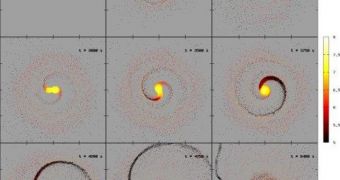Spectral type-R carbon stars are some of the most bizarre bodies in the Universe, simply because of their chemical structure that currently makes no sense for experts. Their atmospheres feature vast amounts of carbon, and very small oxygen concentrations, which is something that experts say shouldn't be the case. One of the greatest mysteries related to this fact is where these carbon concentrations come from. Researchers at the University of Granada Department of Theoretical and Cosmos Physics are currently engaged in a new study that could see this question answered, ScienceDaily reports.
Up until now, the investigation has revolved around establishing as many background information on this type of stars as possible. Supervisors and UGR professors Carlos Abia and Inmaculada Domínguez, together with study leader Olga Zamora Sanchez, have been investigating the distribution of type-R stars across our galaxy, the Milky Way, as well as the bodies' kinematics (motions), their luminosity, and other similar features. There are two types of this peculiar, red, giant star, hot type-R and cold type-R. The classification is based on the surface temperature range that each of the two classes exhibited during research.
R-hot stars were analyzed in the past, but their chemical composition was last established some 25 years ago, using spectral resolutions that were naturally significantly lower than the ones researchers at UGR have at their disposal today. However, the new study is the first ever to have looked at R-cold stars and analyzed the chemical composition of these space structures. Across the Universe, the proportion of carbon to oxygen in 'normal' stars is precisely the other way around, with oxygen dominating and carbon existing in only small amounts. What precisely leads type-R stars to exhibit an inverted ratio is still anybody's guess, and also an issue of great interest to astronomers and astrophysicists.
The UGR investigations have thus far been conducted using the 2.2-meter Almeria Observatory, in Calar Alto. The team managed to analyze the chemical composition of more than 23 type-R stars, both hot and cold, by looking at spectral readings of the bodies. A spectrometer separates light into its basic wavelengths. Each chemical element leaves a unique imprint on these wavelengths, so scientists can tell what chemicals lie in the stars by simply looking at the light they emit. Some of the elements they have discovered thus far in the red giants include carbon, oxygen, nitrogen, lithium, as well as heavy elements including technetium, strontium, barium or lanthanum.
The UGR research is the most complete and thorough worldwide up until now, as far as the observation methods and the theoretical approaches used go. The scientists were also able to devise a numerical model showing a possible formation mechanism for R-hot stars. They concluded that a collision, or fusion, between a helium-rich white dwarf and a regular red giant might have produced the carbon-rich structures. The complete results of the investigation will be published upon completion, in an upcoming issue of the esteemed scientific journal Astronomy & Astrophysics.

 14 DAY TRIAL //
14 DAY TRIAL //